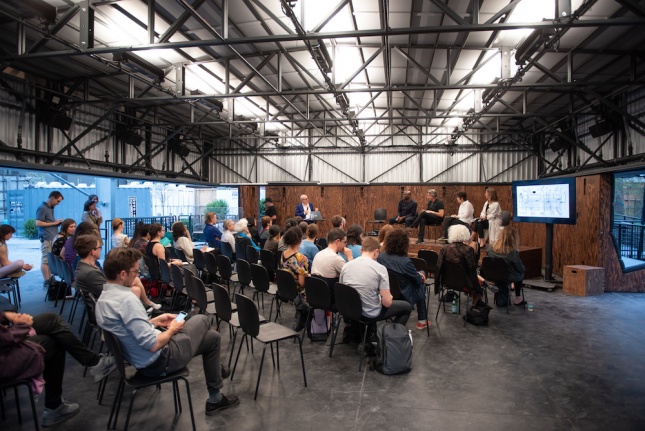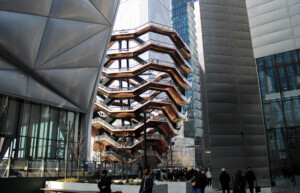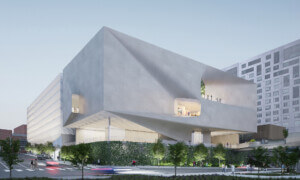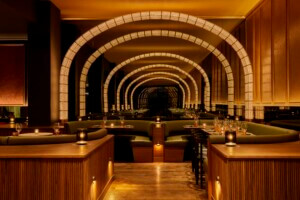In the run-up to the opening of The Shed, Diller Scofidio + Renfro and the Rockwell Group’s new arts center in the Hudson Yards development, a 2-week program called A Prelude to The Shed, featuring free performances, talks and events, took place in a temporary structure designed by Kunlé Adeyemi of NLÉ Works.
A Stroll Through the Fun Palace, British architect Cedric Price’s 1961 project, developed with theater director Joan Littlewood, was presented in dynamic form by architects wheeling models and items from the project archives at the Canadian Centre for Architecture on carts throughout the site, and interacting with curious visitors. A Stroll was originally presented at the 2014 Venice Architecture Biennale at the Swiss Pavilion, where it was curated by Hans Ulrich Obrist, who is also Senior Program Advisor at The Shed.
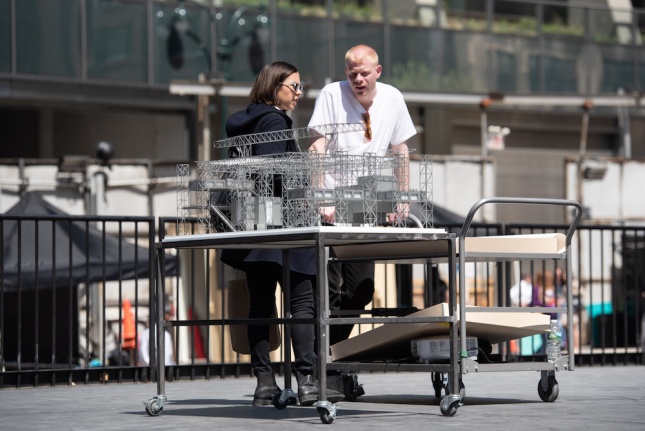
On May 1, the evening panel discussion centered on Price’s Fun Palace and its impact on The Shed. Obrist and Prelude co-programmer Dorothea von Hantelmann set the stage by explaining why they included this work in the roster, and how its presentation explores the exhibition form itself. They correlated the Fun Palace’s interdisciplinary nature—opera, visual art, theater, dance—with Artistic Director Alex Poots’s background at the Manchester International Festival, the Park Avenue Armory and now The Shed.
They were followed by Eleanor Bron, Cedric Price’s concubine (her preferred term for life partner), an actor best known for film roles in Help!, Alfie, Two for the Road, Bedazzled, and Women in Love, and Samantha Hardingham, interim director of the AA and author of Cedric Price Works, 1952–2003: A Forward-Minded Retrospective. They described the challenge for the self-described “anti-architect” to create a home for as many forms of fun in one spot as possible, and to open up science and culture to all. The Fun Palace, intended for the Olympics site in East London, was conceived as a permeable, moveable, gravity-defying open space without beginning or end, in contrast to the prevalent earthbound style of the times in Britain, Brutalism. It counted among is trustees Buckminster Fuller and violinist Yehudi Menuhin, and it nearly happened except for a drainage problem on the site.
In another connection to The Shed, in 1999, Price submitted a proposal for Phyllis Lambert’s Hudson Yards competition, the current site of The Shed. Titled A Lung for Midtown Manhattan, Price was one of five finalists, who also included Ben van Berkel and Caroline Bos, Morphosis, Reiser + Umemoto, and winner Peter Eisenman. The jury consisted of Frank Gehry, Arata Isozaki, Philip Johnson, Rafael Moneo, Joseph Rose (City Planning Commissioner), and Elizabeth Diller. Notably, Diller voted for Price’s entry, which proposed leaving the space open with “wind-blinkers” to encourage breezes from the river to waft over Manhattan.
Diller recounted the competition in the next panel, which also included David Rockwell and Kunlé Adeyemi. Diller and Rockwell discussed their approach to the design of The Shed: to be forever contemporary, flexible but not generic, scalable, indoor and outdoor, unbranded and entrepreneurial. They said their key architecture reference was the Fun Palace, which was an architecture of infrastructure. They also questioned why we need one more cultural institution, since New York City already boasts 12,000. Referring to the moveable portion of The Shed, Rockwell pointed out that many theaters are meant to be flexible (think Zankel Hall at Carnegie Hall), which are rarely utilized because it’s too difficult or expensive. For him, another lesson was from his TED Theater in Vancouver, an annual pop-up meant to be “live.” Here, the architecture does not dictate what happens inside.
The evening was rounded out with Keller Easterling, an architect and Yale professor, who spoke on notions of theater in architectural spaces (in addition to being an architect, she has a background as a performance artist) and Caroline A. Jones, a professor at MIT Architecture, who found parallels in electronic technological modes of production in the art world. They commented that presenters on stage facing the audience was the antithesis of the future Shed.
